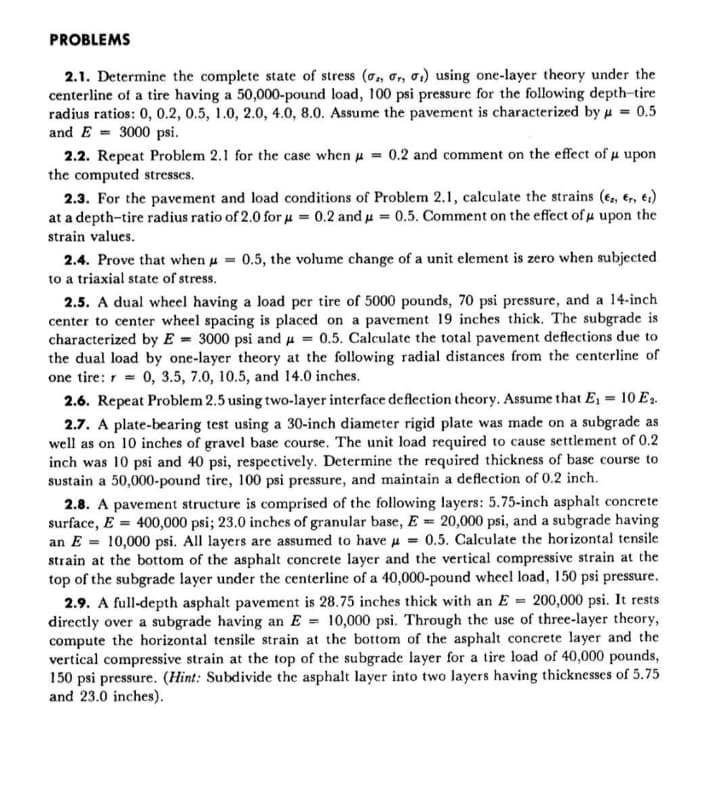PROBLEMS 2.1. Determine the complete state of stress (7, or, o) using one-layer theory under the centerline of a tire having a 50,000-pound load, 100 psi pressure for the following depth-tire radius ratios: 0, 0.2, 0.5, 1.0, 2.0, 4.0, 8.0. Assume the pavement is characterized by u = 0.5 and E = 3000 psi. 2.2. Repeat Problem 2.1 for the case when u = 0.2 and comment on the effect of u upon the computed stresses. 2.3. For the pavement and load conditions of Problem 2.1, calculate the strains (e, tr, ti) at a depth-tire radius ratio of 2.0 for u = 0.2 and u = 0.5. Comment on the effect of u upon the strain values. 2.4. Prove that when u = 0.5, the volume change of a unit element is zero when subjected to a triaxial state of stress. 2.5. A dual wheel having a load per tire of 5000 pounds, 70 psi pressure, and a 14-inch center to center wheel spacing is placed on a pavement 19 inches thick. The subgrade is characterized by E = 3000 psi and u = 0.5. Calculate the total pavement deflections due to the dual load by one-layer theory at the following radial distances from the centerline of one tire: r = 0, 3.5, 7.0, 10.5, and 14.0 inches. 2.6. Repeat Problem 2.5 using two-layer interface deflection theory. Assume that E, = 10 E. 2.7. A plate-bearing test using a 30-inch diameter rigid plate was made on a subgrade as well as on 10 inches of gravel base course. The unit load required to cause settlement of 0.2 inch was 10 psi and 40 psi, respectively. Determine the required thickness of base course to sustain a 50,000-pound tire, 100 psi pressure, and maintain a deflection of 0.2 inch. 2.8. A pavement structure is comprised of the following layers: 5.75-inch asphalt concrete surface, E = 400,000 psi; 23.0 inches of granular base, E = 20,000 psi, and a subgrade having an E = 10,000 psi. All layers are assumed to have µ = 0.5. Calculate the horizontal tensile strain at the bottom of the asphalt concrete layer and the vertical compressive strain at the top of the subgrade layer under the centerline of a 40,000-pound wheel load, 150 psi pressure. 2.9. A full-depth asphalt pavement is 28.75 inches thick with an E = 200,000 psi. It rests directly over a subgrade having an E = 10,000 psi. Through the use of three-layer theory, compute the horizontal tensile strain at the bottom of the asphalt concrete layer and the vertical compressive strain at the top of the subgrade layer for a tire load of 40,000 pounds, 150 psi pressure. (Hint: Subdivide the asphalt layer into two layers having thicknesses of 5.75 and 23.0 inches).

Trending now
This is a popular solution!
Step by step
Solved in 2 steps

Determine the complete state of stress (δz , δr , δt ) using one layer theory under the
centerline of a tire having 50000 Ib load, 100psi pressure for the following depth-tire
radius ratios: 0, 0.5, 2. Assume the pavement is characterized by μ = 0.5 and E =
3000psi.
A dual wheel having a load per tire of 5000 Ib, 70 psi pressure and μ = 0.5. Calculate the
total pavement deflections due to the dual wheel by one-layer theory at the following
radial distances from the centerline of one tire: r=0, 3.5,10.5. (Use Pavement Thickness
= 8in).
A dual wheel having a load per tire of 4000 Ib, 80 psi pressure and μ = 0.5. Calculate the
total pavement deflections due to the dual wheel by two layer theory at the following
radial distances from the centerline of one tire: r=0, 7,14. Assume that E1 = 10 E2



